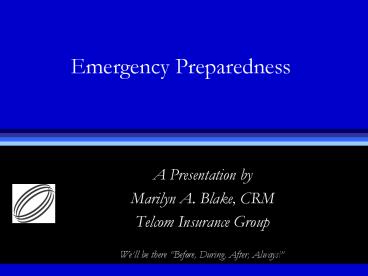Emergency Preparedness - PowerPoint PPT Presentation
1 / 16
Title:
Emergency Preparedness
Description:
So, EVERYONE must be ready to act (according to their assigned roles) Think About This... can help (Fire department, Red Cross, National Weather Service, Police ... – PowerPoint PPT presentation
Number of Views:47
Avg rating:3.0/5.0
Title: Emergency Preparedness
1
Emergency Preparedness
- A Presentation by
- Marilyn A. Blake, CRM
- Telcom Insurance Group
- Well be there Before, During, After, Always!
2
What is an Emergency?
- Any unplanned event that can cause deaths or
significant injuries to employees, customers, or
the public - Or, that can shut down your business, disrupt
operations, cause physical/environmental damage,
or threaten the companys financial standing or
public image.
3
What are Examples of an Emergency?
- Fire
- Flood
- Hurricane
- Tornado
- Winter storm (snow/ice/hail)
- Earthquake
- Lightning
- Wind Storm
- Roof collapse
- Tower damage
- Power surges
- Communications failure
- Explosion
- Civil disturbance
- Unexpected loss of key supplier
4
Every Year Emergencies Take Their Toll on
Business in Lives and Dollars
- Goal of the Plan Limiting injuries and damages
and returning more quickly to normal operations
5
Whos Job is it?
- Preparedness is EVERYONEs job during the first
few hours/days following an emergency, essential
services may not be available. So, EVERYONE must
be ready to act (according to their assigned
roles)
6
Think About This...
- How long will your business last without
computers or operating switches? - What would happen if you were denied access to
your facilities, server, or customer records? - How long could you work without telephone
service, electricity, water (utilities) or run
only on generators? - If your building survived, without an emergency
preparedness plan, you have no guarantee that
your business would.
7
What is Emergency Planning?
- It is the process of preparing for, mitigating,
responding to, and recovering from an emergency - The process is dynamic
- Planning is critical, but training, drills,
testing equipment, and community coordination are
also essential components
8
Reasons to Develop a Plan
- Likelihood of an emergency
- Safeguarding life and property (physical and
financial) - Employee morale
- Liability as utility provider
- Public image
- OSHA requirement (1910)--must be written if you
have more than 10 employees
9
4 Steps in the Planning Process
- 1. Establish a planning team
- 2. Analyze capabilities and hazards
- 3. Develop the plan
- 4. Implement the plan
10
1-Establish the Team
- Size of the team will depend on the facility, but
a group is best - Functional areas to include are
- Upper management
- Safety coordinator
- Line management
- Human Resources
- Engineering/maintenance
- PR/Community relations (links to community
organizations) - Accounting/purchasing
- Legal
11
2-Analyze
- Many documents are already in place (evacuation
plan, employee manuals, insurance/risk management
policies, purchasing procedures, etc.) - List potential emergencies (historical examples,
technological possibilities, human error factor),
their probability, and the best way to minimize
it - Local organizations can help (Fire department,
Red Cross, National Weather Service, Police
department, construction companies, etc.)
12
2-Analyze (Cont)
- Review your insurance risk management policies
- Are property values up-to-date?
- Do you have coverage for floods, earthquakes,
winter storms, tornadoes, etc.? - Do you have redundant systems to minimize your
business interruption exposure in case of
emergency? - What are your deductibles?
- What about lost toll or data records?
- Do you know how to call in a claim?
13
3-Develop the Plan
- Executive summary/mission statement
- Procedures (for reporting, escape, evacuation,
resumption of operations) - Support documents (call lists, site maps)
- Write the document (review and distribute)
- Establish a training schedule for employees
- Obtain upper management approval
- Distribute to employees
- Telcom has prepared a sample fill-in-the-blank
telco-specific - document as a starting point for Step 3
14
4-Implement the Plan
- Must become part of the corporate culture
- Should have walk-through and functional drills
- Evaluate and modify the plan as new operations
begin or as situations dictate - Make sure employees have read the plan and
understand it and their roles
15
An Ounce of Prevention
- No emergency preparedness plan can guarantee that
your telephone company wont suffer any
losses--but it can minimize the damage and help
use all of your resources to protect your
employees and your business.
16
Resources
- Telcom Insurance Group (www.telcominsgrp.com or
800-222-4664) - www.FEMA.gov
- www.OSHA.gov
- www.EPA.gov
- www.RedCross.org































